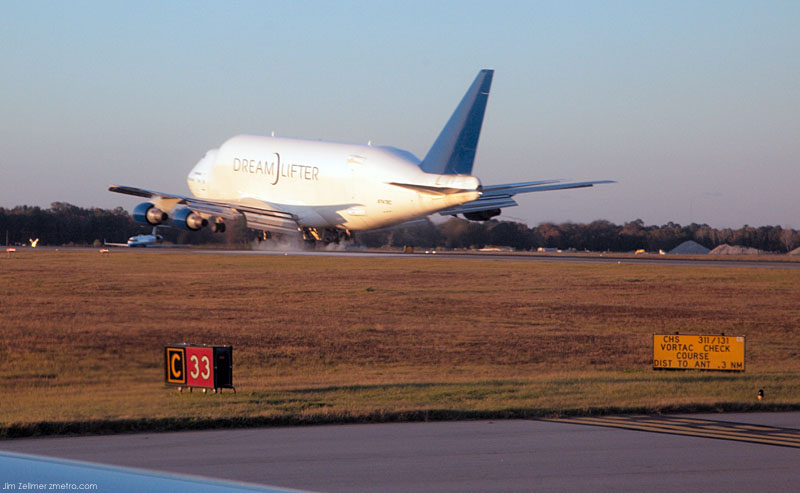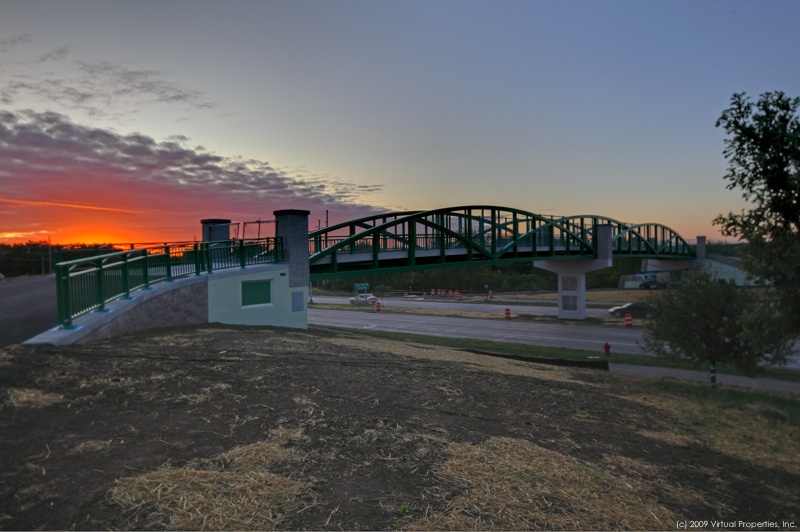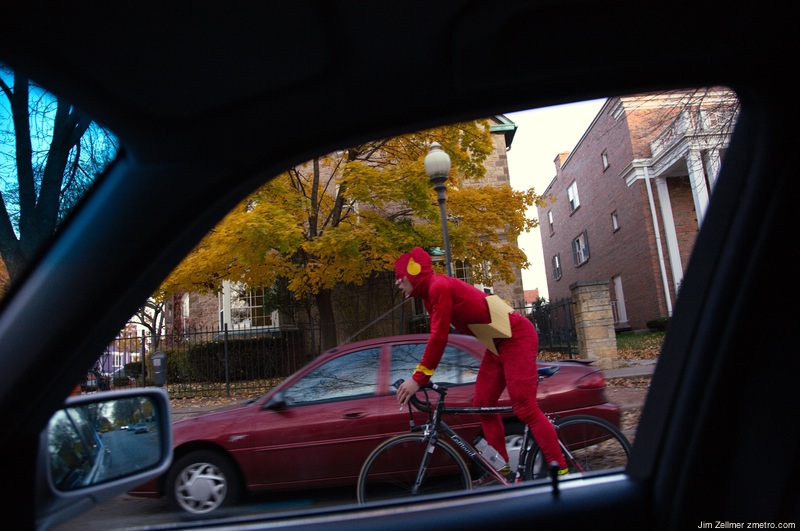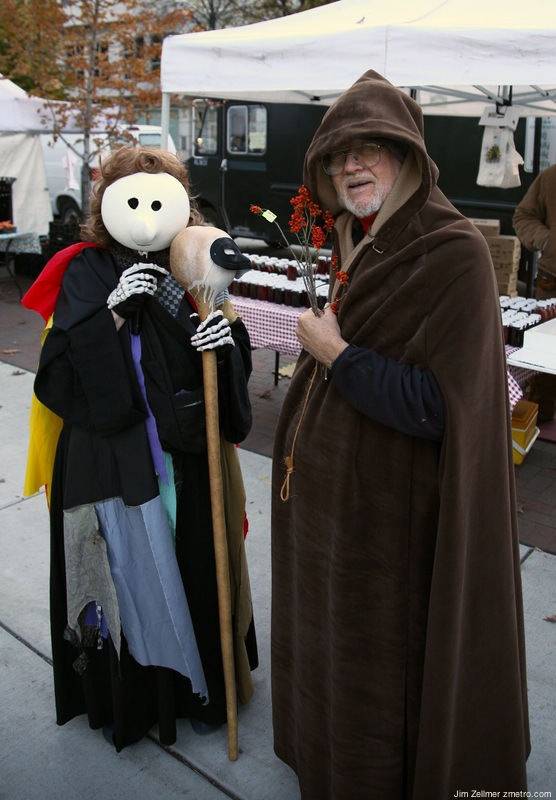Austin-Bergstrom International Airport website. Just in time for South by Southwest 2010.
Click to view the full screen panorama.
Category: Transportation
Global Supply Chain for Boeing’s New 787: The DreamLifter in Action

With the recent first flight of Boeing’s new 787, I thought it timely to post a photo from it’s supply chain: a converted 747 freighter known as the “Dreamlifter” that flies parts from around the globe to Everett, Washington for final assembly.
The Truth About the TATA Nano
hy is a soon-to-be success story gathering dust at TATA dealers across India? Much like the initial growing pains of the Ford Model T, the $2000 Nano currently lies on waiting list. Given the lopsided supply/demand and construction conflagrations with the government, I reckon enterprising Indians are flipping the Nanos living in parking lot limbo for profit. Still, my precious few moments sitting in somebody’s dusty Nano left me impressed. Not because it was a perfect machine: I saw automotive history in the making.
Rarely in America is a car designed around a vision: witness the overweight performance icons clawing for yesteryear’s glory, car based trucks and globally designed, badge engineered atrocities. Not with the TATA Nano: behold the homegrown hero.
The Nano is born from an undying need for affordable transportation in a country with a growing but repressed middle class. This group needs a family vehicle superior to tube frame rickshaws and 150cc motorcycles carrying four or more people. Yes, really: I saw a family of four riding a motorcycle through the congested, fast paced, life threatening streets of Bangalore. Make no mistake: a car at this price and size is the automotive embodiment of “If you Build It, They Will Come.”
It’s all about the lakhs; the Nano is designed around a price befitting the Indian working class. One look around the beast shows the good, bad and ugly of the situation.
Exterior fit and finish is respectable, until you spot the unfinished rear hatchback seams, hurriedly painted over. That stylish rear hatch is glued shut, so cargo is only accessible from the rear seat. And the list of price-conscious ideas doesn’t stop: three-lug wheels, single arm wiper blade and an adorable looking center exit exhaust.
The Ghost Fleet of the Recession
The biggest and most secretive gathering of ships in maritime history lies at anchor east of Singapore. Never before photographed, it is bigger than the U.S. and British navies combined but has no crew, no cargo and no destination – and is why your Christmas stocking may be on the light side this year.
The tropical waters that lap the jungle shores of southern Malaysia could not be described as a paradisical shimmering turquoise. They are more of a dark, soupy green. They also carry a suspicious smell. Not that this is of any concern to the lone Indian face that has just peeped anxiously down at me from the rusting deck of a towering container ship; he is more disturbed by the fact that I may be a pirate, which, right now, on top of everything else, is the last thing he needs.
His appearance, in a peaked cap and uniform, seems rather odd; an o fficer without a crew. But there is something slightly odder about the vast distance between my jolly boat and his lofty position, which I can’t immediately put my finger on.
Then I have it – his 750ft-long merchant vessel is standing absurdly high in the water. The low waves don’t even bother the lowest mark on its Plimsoll line. It’s the same with all the ships parked here, and there are a lot of them. Close to 500. An armada of freighters with no cargo, no crew, and without a destination between them.
Sunrise: Fitchburg’s New Pedestrian & Bicycle Bridge

Airbus A380 in Oshkosh!
Of all the planes to touch down in Oshkosh this week, one towers above all others. That’s the Airbus A380.
We’ve written about the 380 before, and it’s tough to call a plane that’s already in service at three different airlines experimental, but today Airbus gave us – and the rest of the crowd here – something much cooler than your typical commercial jet landing. Flying in from Toulouse (via Milwaukee) under the command of test pilot Terry Lutz, the 380 did multiple flybys over the airfield, showing off for the thousands of assembled plane watchers before touching down at 3:15 local time.
As the plane rolled to a stop, it’s four engines still roaring, we couldn’t help but be awed all over again by its sheer size: 239 feet long, 79 feet high, with a wingspan of almost 80 269 feet and weighing in at 610,000 pounds. Seeing the plane in the company of so many other things with wings (some of them not so small themselves) puts those numbers in perspective. And while it might seem silly to call an aircraft the size of the A380 graceful, there’s no other way to describe the way it gently turned and banked as it circled the airfield before making its final approach. We’ve made it clear from the start that we love this plane, and today in Oshkosh we found a reason to love it a little bit more.
Who Switched the Playbooks
When I was starting up in China, many experts cautioned me on what I would encounter. “It’s not a free market and there’s no rule of law, they told me. “The government controls the courts, the companies and the banks. Central planners in Beijing, not the marketplace, decide what goods to produce and which companies should produce them.”
“Decisions are made for political, not economic reasons,” they went on to explain. “The heads of China’s state-owned enterprises serve at the pleasure of the Party, the banks are told what loans to make, and making a profit is secondary to ensuring employment. That’s the reason why China’s banks are a mess and full of non-performing loans.”
Occasionally, I would push back, noting the economic progress that China had made since Deng Xiaoping opened the economy in 1978. “You don’t believe the government’s numbers, do you?” they would ask incredulously. “Everyone knows they’re manufactured to convey whatever message the government wants. And, when it comes to financial statements, forget it. Chinese companies have at least three sets of books, and you can’t believe any of them.”
Bangle Bids Adieu
When it comes time to chart designer Chris Bangle’s contribution to the BMW brand’s aesthetic, few pundits will praise his pulchritudinous perversion of pistonhead passion, or thank him for the aesthetic affectations for which BMW is now known. In other words, the “Bangle Butt” will be Chris’ lasting legacy. Of course, this is also the man who removed the words “flame surfacing” from art school and placed them on the tip of his detractors’ tongues. That and Axis of White Power. (Oh! How we laughed!) Equally improbably, the Buckeye State native helped the expression “Dame Edna glasses” cross into the automotive lexicon. Yup. It’s been a wild ride. Literally.
CAR:
BMW design boss Chris Bangle is to leave the car industry, it was announced today. In a statement, BMW said Bangle was quitting ‘to pursue his own design-related endeavors beyond the auto industry.’
Bangle, 52, was the architect of the often controversial flame surfacing look that transformed BMW design from the Russian doll mentality of the 1990s to the edgy – some would say radical and divisive – styling of today.
The cars Bangle spannered
The outgoing design chief has overseen the launch of the current 1-, 3-, 5- and 7-series saloons and hatchbacks, as well as the raft of niche models that have seen BMW’s model range explode in recent years: the Z3, Z4, Z8, X3, X5, X6 and 6-series were all conceived on his watch.
Bangle grew up in Wausau, WI.
I give him a great deal of credit for dramatically changing what is often a very conservative business: car design.
Protesters Force Bangkok’s Airport to Suspend Takeoffs

AP:
Anti-government demonstrators swarmed Bangkok’s international airport late Tuesday — halting departing flights — as opponents and supporters of Thailand’s government fought running battles in the streets of the city.
Minutes after outbound flights at Suvarnabhumi International Airport were suspended, hundreds of demonstrators — some masked and armed with metal rods — broke through police lines and spilled into the passenger terminal.

The road to Suvarnabhumi.

Quintessential Madison: Halloween 2008

An in-costume cyclist early Saturday morning. Madison, WI.
Another very Madison Halloween image, this time, an older couple:

